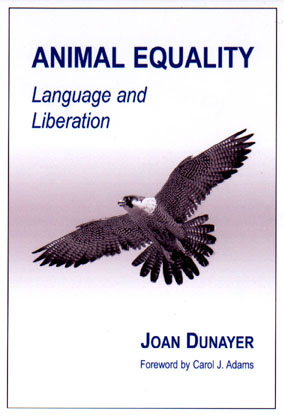Book Review
ANIMAL EQUALITY:
LANGUAGE AND LIBERATION
By Joan Dunayer (Forward by Carol J. Adams)
Hardcover, 283 pages
$25 from Ryce Publishing (301-330-9547 or
info@rycepublishing.com)

People use language to express thoughts and feelings. Few people are aware, however, of the degree to which language actually shapes our thoughts and feelings. The words we read and hear color our thoughts and feelings about the information denoted by those words. At the same time, the vocabulary available to us and the structure of the language we speak delimit what we are able to express and even what we are able to think.
Joan Dunayer's new book, Animal Equality: Language and Liberation ($25, Ryce Publishing), explores many of the ways in which American language practices concerning nonhuman animals contribute to the perpetuation of the abuse of nonhuman animals. Dunayer's book is both descriptive and prescriptive. In chapters concerning hunting, sportfishing, zoos and aquariums, vivisection, and the animal-based food industries, Dunayer provides a plethora of examples of deceptive language practices which obscure, minimize, or deny the abuse of animals. In chapters on "pronoun politics" and categorization, as well as in her section on style guidelines, Dunayer prescribes more accurate and empathic language usage.
This multifaceted book might be utilized in any number of ways by an animal liberation activist. For example, having read the chapter on sportfishing, one might use the examples therein to challenge the language usage of newspaper articles concerning that topic. In all of the chapters concerning specific types of abuses of animals, Dunayer provides a great deal of basic factual information in the course of refuting common deceptive language practices. Those chapters are therefore very appropriate for those new to the movement or those who are not yet aware of the extent of the deprivation and mistreatment endured by animals in various human-engineered circumstances.
With regard to chickens, Dunayer concentrates primarily on the language used by the humans involved in their enslavement, mutilation, and murder. Speaking of hens squeezed into cages so tightly that they can barely move, one factory owner said "They hardly have to move to get food or water," thus implying that such accommodations are luxurious. Those involved in the mutilation of birds by slicing a hot blade through their beaks typically call the operation "beak trimming," as if it were the equivalent of clipping one's nails. Such language practices help those involved in the meat and egg industries to hide what they are doing from themselves. Other practices, such as calling egg factories by such names as "Happy Hen Egg Ranch," help to deceive consumers.
More general linguistic practices described by Dunayer impact human perceptions of chickens, thereby making the abuse of chickens more easy. For example, Dunayer describes the many ways in which common language practices draw a thick line between human and nonhuman animals. This inhibits our ability to empathize with animals, making it easier for us to hurt them.
Another common linguistic practice described by Dunayer is the use of 'animal' metaphors to denote negative characteristics in humans. As Dunayer notes, words associated with hens are used in a sexist manner to ascribe negative characteristics to women. The connection is significant, since both hens and human women historically have been subjugated so that their reproductive capacities could be exploited. Both have been seen as valuable only when fertile and both have been denigrated and discarded in old age.
Dunayer's book is the first to concentrate on the linguistic aspects of the abuse of nonhuman animals. Like all first treatments, this book raises as many questions as it answers. For example, cognitive psychologists (using consenting human subjects) have found that, faced with a disagreement between language and belief (or between behavior and belief), people will change one or the other in order to relieve the tension brought about by the dissonance. But, whether people change their belief or their behavior depends upon other factors, such as the degree of profit or loss involved in each choice. Most often, people change their language or beliefs to fit their behavior rather than vice versa. What are the implications of this for Dunayer's program of language change? Beyond modeling appropriate language usage ourselves, what else do we need to do to bring about the changes envisioned by Dunayer? What can the research concerning rhetorical strategies tell us about the effectiveness of different linguistic tactics or the counter-attacks we are likely to face? Does the history of how languages change over time tell us anything about how to consciously stimulate such change? One hopes that, in future, another scholar (or perhaps Dunayer herself) will answer these and other questions in order to craft a practical program of strategies to challenge the deceptive practices Dunayer has so well identified and described.
Dunayer notes that "words can foster oppression or liberation, deception or truth" and that is certainly true. Going further, Dunayer asserts that "speciesism can't survive without lies" and that "honest words will grant [nonhuman animals] the freedom and respect that are rightfully theirs." That is probably overly hopeful. In human animals, cognition, emotion, and behavior are complexly interrelated. Language is only one of many variables influencing cognition while cognition is only one of many variables influencing behavior. Given all of the other variables which support the ongoing abuse of nonhuman animals, it seems unlikely that changes in language alone will grant freedom to animals.
While changes in linguistic practices will not in themselves bring about animal liberation, such changes certainly must be an element of the animal liberation movement. In other words, changes in language are necessary but not sufficient to bring an end to human exploitation and abuse of nonhuman animals. Precisely because such changes will be necessary, Dunayer's book represents an important contribution to the struggle for animal liberation.